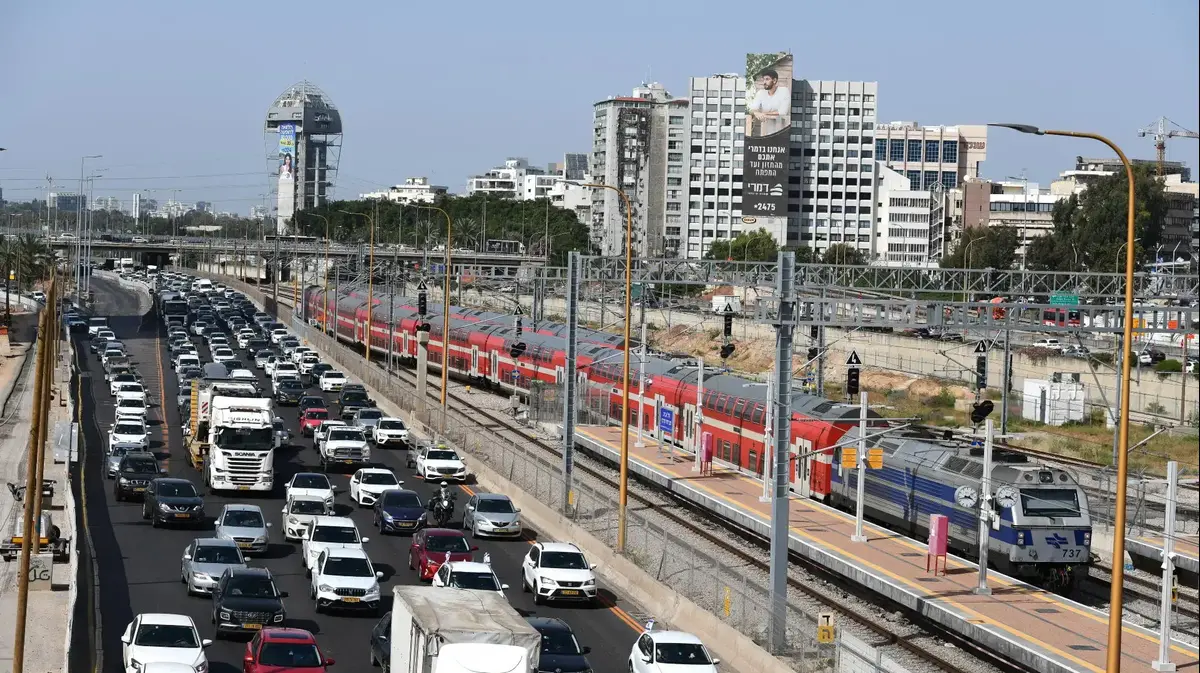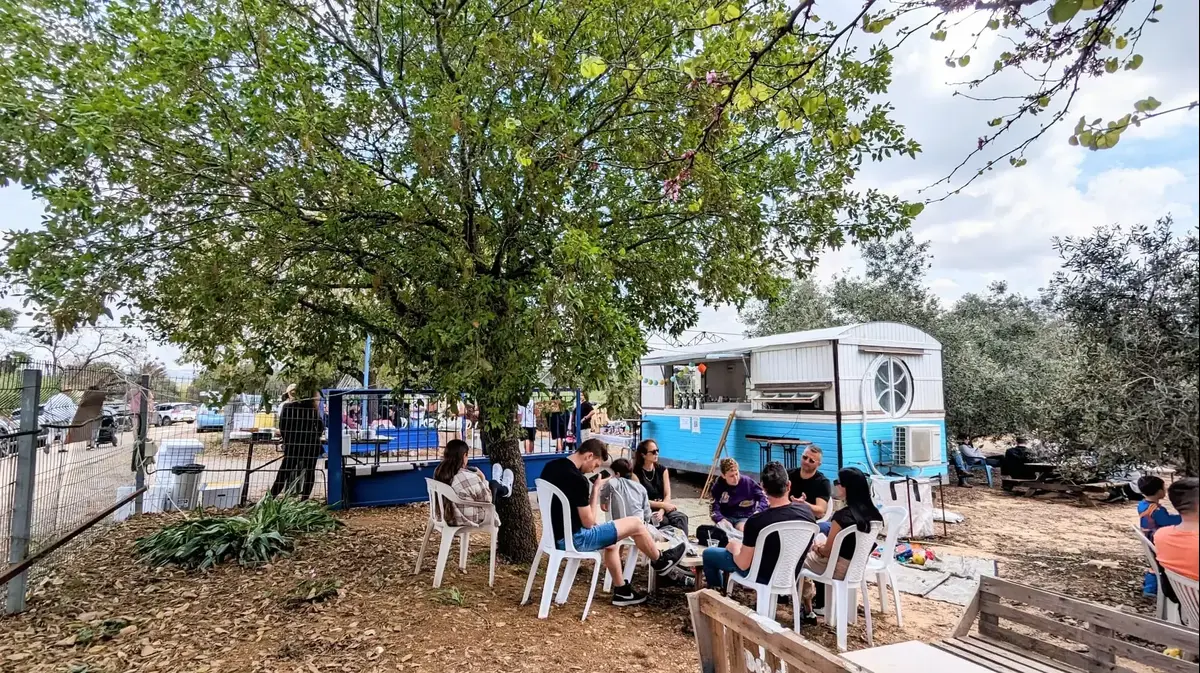news
News in Israel
Events in Israel
This morning, too, you stood in traffic jams for a long time.
That will not change in the next decade
The long lines of cars that congest the roads in Israel on a daily basis are not the problem, they are the symptom of a much more serious malfunction related to transportation management policy.
From the Walla!
It appears that there are solutions that are already at work these days, but do not develop expectations before 2030
Tags
traffic jams
Metro
The light rail in Gush Dan
Keenan Cohen
Monday, April 26, 2021, 11:00 p.m.
Share on Facebook
Share on WhatsApp
Share on general
Share on general
Share on Twitter
Share on Email
0 comments
Israel is in a very bad place in the OECD's transport indices.
Ayalon Lanes, this month (Photo: Reuven Castro)
Tens of thousands of vehicles also stood in traffic jams across the country this morning (Monday).
The transport crisis has been plaguing road users for years, and Israel is in a very bad place in the OECD's transport indices.
We "lead" only in the gap in vehicle density per km of asphalt, we are a little above average in vehicle travel (second only to the United States) and all this with a smaller than average amount of vehicles per capita.
In other words, in Israel there are fewer cars per capita than average In the OECD, but they cover more miles and are still more crowded at those miles - paradox? Absolutely.
More on Walla!
Ben Gurion Airport's catch: Israel leaves the corona, but the purple mark ground the return to routine
To the full article
for further reading
A visit to the museum?
Do not rely on public transportation
Demand for experiments has soared, and the first skimmer field in Israel will be built in Yeruham
Changing attitudes: What furniture did the Israelis buy in closure and what are they buying now?
A report published by the OECD and supported by data from the Knesset Research Center explicitly states: "Traffic congestion in urban areas, especially in the Tel Aviv metropolitan area, is unusual and severe. It is likely that these congestion will exacerbate productivity and quality of life."
The conclusions of this section of the report state that in the short term, the most effective tool to deal with these loads is the use of a congestion charge.
According to the plan presented in the report, if the use of a set of congestion fees at a cost that varies according to the loads and demand, will lead to a decrease of only 5% in the volume of traffic - the actual improvement will be tangible and noticeable.
Encouraging drivers to move to shared transportation, encouraging work from home even for part of the time, changing departure hours to those after peak hours - these are some of the solutions proposed in the report.
The money that will be accumulated from the congestion charges, the OECD offers to invest in the construction, expansion and improvement of public transportation.
Public trickery or public transportation?
"We are seeing an increase in most hours of the day of up to 90% from what it was before, and during rush hours even more"
And it's not just your subjective feeling when you stare at the car seat in front of you and your knuckles tighten on the steering wheel in frustration.
"If we look at the increase in the number of vehicles compared to February of last year, we see an increase in most hours of the day of up to 90% from what it was before, and during rush hours even more," said Adi Kein Karni, vice president of "Fast to the City" "Where's the money" on 103FM radio.
Similar data
emerges
from a survey we conducted on WAZE's information systems, since March 1, 2021, excluding the two days of Passover itself (March 27-28). Traffic on the roads is significantly higher than in February 2020, ie before the corona epidemic. So what exactly is happening on the roads?
Israel has been in a transportation crisis for many years.
In fact, from the second half of the 1990s until a few years ago, the solution to increasing the number of vehicles was one - to pave more roads, expand existing ones and add interchanges.
The result was completely different.
This is because as more lanes and roads are added, the initial relief of congestion encourages more and more people to get on these free roads.
The billions of shekels invested in the construction of interchanges in the north and south had good intentions - the creation of a continuum of travel from the Galilee to the center as part of a vision of connecting the periphery.
And this is indeed what actually happened - now the residents of Carmiel, Tiberias and Safed have an easy, fast and convenient option to get to the traffic jams in the center.
The gap in numbers
Even after the allocation of resources in the years 2000 to 2010, public transportation in Israel lagged behind the world standard by 86%.
In 2011-2010, the investment in roads was about seven billion shekels, in public transportation about two billion shekels.
A gap that narrowed only in late 2015 and early 2016, when the budgets invested in public transport surpassed those buried in infrastructure.
The increase in budgeting was the result of a strategic plan published in 2012 by the Ministries of Finance and Transportation, which included an investment of NIS 250 billion for 25 years - that is, about NIS 10 billion a year on average.
Since then, at least according to the Knesset Research Center, the actual sums have stood at about half.
Public transportation in Israel lags behind what is accepted in the world.
Ayalon Lanes, this month (Photo: Reuven Castro)
Even if at the moment it is mainly causing inconvenience, the change in these priorities we see in recent years in the streets of Gush Dan being excavated for the light rail, accelerating processes to start work on the metro, promoting the establishment of highways that will carry people around the clock to city centers and recreation areas. , While their cars will remain in huge parking lots.
But the schedules of all these changes are not measured in weeks or months, but in years. Some? Depends on what project it is. According to sources in Ayalon lanes, when it comes to highways, if everything goes well, it will be possible to inaugurate the first sections in 2025. The light rail, whose opening has been repeatedly postponed, is expected to operate the red line in 2023 and the green line and the purple line in 2027 and 2026 respectively.
Whoever is supposed to be the real traffic jam in Israel's transportation complex - the metro train, for its partial operation have to wait for the year 2032 according to the optimistic scenario, 2035 according to the real scenario and 2040 for its full operation.
The light rail works in Tel Aviv, this month (Photo: Reuven Castro)
Those who pinned hopes on changing our transportation habits following the Corona Year, especially when it comes to work-from-home options - found out very quickly with a return to routine that it was a short-lived episode, one that failed to break years of habits.
With each stage of the economy returning to normal, the cars have re-filled the roads, with its full opening - the situation is already out of control.
So basically, if we went back to the routine as we knew it before the corona, why did the situation on the roads become more problematic?
Well, remember the explanation about the sputtering public transportation?
So the same system that even before the corona was not a great bargain was joined this year by other factors that distanced the public from it even further.
Fear of crowded places (public transportation was one of the hotspots - KK), frequent changes in schedules, cancellations of lines, congestion restrictions, long shutdown of the train and its return to non-full-scale activity and the need to issue a voucher on each trip and more accumulated for a list of reasons Lost confidence in his public transportation.
The metro is expected to be the real traffic jam, but it will not operate until at least 2032.
Imaging of the metro (Photo: Official website, NATA)
During the Corona period, even those who previously traveled by public transport by choice - could no longer trust it and bought cars, lots of cars
As a result, during the Corona period, even those who had previously traveled by public transport by choice - could no longer trust it and bought cars, lots of cars, mostly used or small and cheap.
And when car maintenance in Israel is so expensive - the licensing, insurance, fuel and maintenance fees - for most people a car that is parked while maintaining it so expensive is a waste.
Add to that the problematic culture of benefiting the attached vehicle, both in the private and public sectors - and what you get is the colorful mosaic landscape of a car that stretches along and across Israel's major traffic arteries.
Demography vs. Geography
In order to simplify the essence of the transportation problem in the most significant way, it is not necessary to dig into the protocols of the planning committees and not of government decisions to accelerate public transportation projects. The basic fact is that we are just proliferating, building houses and buying cars faster than we are paving roads.
Simply put: every year about 130,000 new cars are added to the roads (after deducting from the number of new cars those that come off the roads - KK), while estimates by officials in Netivei Israel are that no more than a few tens of km of roads are paved each year, and this includes Expansion of lanes, bypass roads and more.
Unfortunately, this story has no happy ending, the transportation crisis in Israel does not currently have a magic solution in the near future.
As long as the state does not operate, whether by the carrot method or the stick method, arrays that will be encouraged beyond collaborative travel, employers and workers will be rewarded according to a key of working remotely for those whose occupation allows it, will overcome and improve reliable public transportation. - The chance of seeing a change, any change that will facilitate even a little, is not small - it simply does not exist.
There is a saying in the field of transportation planning that "an advanced country is not the one where the poor have a car, but the one where the rich travel by public transport" - in Israel they seem to be pushing hard in the opposite direction from this statement, and we all pay the price.
In time, money and health.
Share on Facebook
Share on WhatsApp
Share on general
Share on general
Share on Twitter
Share on Email
0 comments







/cloudfront-eu-central-1.images.arcpublishing.com/prisa/KMEYMJKESBAZBE4MRBAM4TGHIQ.jpg)


